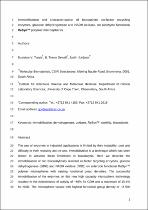 ResearchSpace
ResearchSpace
Immobilisation and characterisation of biocatalytic co-factor recycling enzymes, glucose dehydrogenase and NADH oxidase, on aldehyde functional ReSynTM polymer microspheres
JavaScript is disabled for your browser. Some features of this site may not work without it.
- ResearchSpace
- →
- Research Publications/Outputs
- →
- Journal Articles
- →
- View Item
| dc.contributor.author |
Twala, BV

|
|
| dc.contributor.author |
Sewell, BT

|
|
| dc.contributor.author |
Jordaan, J

|
|
| dc.date.accessioned | 2012-11-23T13:43:34Z | |
| dc.date.available | 2012-11-23T13:43:34Z | |
| dc.date.issued | 2012-03 | |
| dc.identifier.citation | Twala, B.V, Sewell, B.T and Jordaan, J. 2012. Immobilisation and characterisation of biocatalytic co-factor recycling enzymes, glucose dehydrogenase and NADH oxidase, on aldehyde functional ReSynTM polymer microspheres. Enzyme and Microbial Technology, Vol. 50, pp 331-336 | en_US |
| dc.identifier.issn | 0141-0229 | |
| dc.identifier.uri | http://www.sciencedirect.com/science/article/pii/S0141022912000348 | |
| dc.identifier.uri | http://hdl.handle.net/10204/6370 | |
| dc.description | Copyright: 2012 Elsevier. This is a pre-print version of the work. The definitive version is published in Enzyme and Microbial Technology, Vol. 50, pp 331-336. | en_US |
| dc.description.abstract | The use of enzymes in industrial applications is limited by their instability, cost and difficulty in their recovery and re-use. Immobilisation is a technique which has been shown to alleviate these limitations in biocatalysis. Here we describe the immobilisation of two biocatalytically relevant co-factor recycling enzymes, glucose dehydrogenase (GDH) and NADH oxidase (NOD) on aldehyde functional ReSynTM polymer microspheres with varying functional group densities. The successful immobilisation of the enzymes on this new high capacity microsphere technology resulted in the maintenance of activity of 40% for GDH and a maximum of 15.4% for NOD. The microsphere variant with highest functional group density of ~3500 mol g-1 displayed the highest specific activity for the immobilisation of both enzymes at 33.22 U mg-1 and 6.75 U mg-1 for GDH and NOD with respective loading capacities of 51% (0.51 mg mg-1) and 129% (1.29 mg mg-1). The immobilised GDH further displayed improved activity in the acidic pH range. Both enzymes displayed improved pH and thermal stability with the most pronounced thermal stability for GDH displayed on ReSynTM A during temperature incubation at 65 C with a 13.59 fold increase, and NOD with a 2.25-fold improvement at 45 C on the same microsphere variant. An important finding is the suitability of the microspheres for stabilisation of the multimeric protein GDH. | en_US |
| dc.language.iso | en | en_US |
| dc.publisher | Elseveir | en_US |
| dc.relation.ispartofseries | Workflow;9883 | |
| dc.subject | Immobilisation | en_US |
| dc.subject | Dehydrogenase | en_US |
| dc.subject | Oxidase | en_US |
| dc.subject | ReSynTM | en_US |
| dc.subject | Biocatalysis | en_US |
| dc.title | Immobilisation and characterisation of biocatalytic co-factor recycling enzymes, glucose dehydrogenase and NADH oxidase, on aldehyde functional ReSynTM polymer microspheres | en_US |
| dc.type | Article | en_US |
| dc.identifier.apacitation | Twala, B., Sewell, B., & Jordaan, J. (2012). Immobilisation and characterisation of biocatalytic co-factor recycling enzymes, glucose dehydrogenase and NADH oxidase, on aldehyde functional ReSynTM polymer microspheres. http://hdl.handle.net/10204/6370 | en_ZA |
| dc.identifier.chicagocitation | Twala, BV, BT Sewell, and J Jordaan "Immobilisation and characterisation of biocatalytic co-factor recycling enzymes, glucose dehydrogenase and NADH oxidase, on aldehyde functional ReSynTM polymer microspheres." (2012) http://hdl.handle.net/10204/6370 | en_ZA |
| dc.identifier.vancouvercitation | Twala B, Sewell B, Jordaan J. Immobilisation and characterisation of biocatalytic co-factor recycling enzymes, glucose dehydrogenase and NADH oxidase, on aldehyde functional ReSynTM polymer microspheres. 2012; http://hdl.handle.net/10204/6370. | en_ZA |
| dc.identifier.ris | TY - Article AU - Twala, BV AU - Sewell, BT AU - Jordaan, J AB - The use of enzymes in industrial applications is limited by their instability, cost and difficulty in their recovery and re-use. Immobilisation is a technique which has been shown to alleviate these limitations in biocatalysis. Here we describe the immobilisation of two biocatalytically relevant co-factor recycling enzymes, glucose dehydrogenase (GDH) and NADH oxidase (NOD) on aldehyde functional ReSynTM polymer microspheres with varying functional group densities. The successful immobilisation of the enzymes on this new high capacity microsphere technology resulted in the maintenance of activity of 40% for GDH and a maximum of 15.4% for NOD. The microsphere variant with highest functional group density of ~3500 mol g-1 displayed the highest specific activity for the immobilisation of both enzymes at 33.22 U mg-1 and 6.75 U mg-1 for GDH and NOD with respective loading capacities of 51% (0.51 mg mg-1) and 129% (1.29 mg mg-1). The immobilised GDH further displayed improved activity in the acidic pH range. Both enzymes displayed improved pH and thermal stability with the most pronounced thermal stability for GDH displayed on ReSynTM A during temperature incubation at 65 C with a 13.59 fold increase, and NOD with a 2.25-fold improvement at 45 C on the same microsphere variant. An important finding is the suitability of the microspheres for stabilisation of the multimeric protein GDH. DA - 2012-03 DB - ResearchSpace DP - CSIR KW - Immobilisation KW - Dehydrogenase KW - Oxidase KW - ReSynTM KW - Biocatalysis LK - https://researchspace.csir.co.za PY - 2012 SM - 0141-0229 T1 - Immobilisation and characterisation of biocatalytic co-factor recycling enzymes, glucose dehydrogenase and NADH oxidase, on aldehyde functional ReSynTM polymer microspheres TI - Immobilisation and characterisation of biocatalytic co-factor recycling enzymes, glucose dehydrogenase and NADH oxidase, on aldehyde functional ReSynTM polymer microspheres UR - http://hdl.handle.net/10204/6370 ER - | en_ZA |





